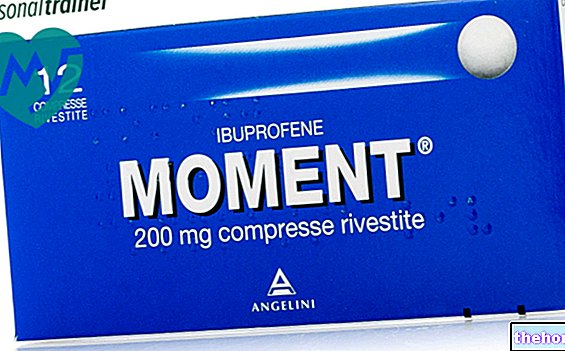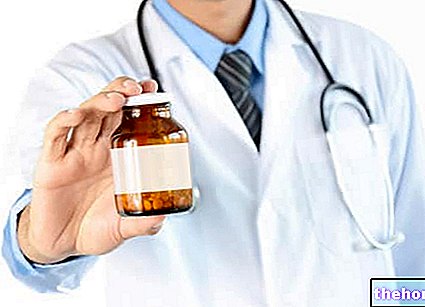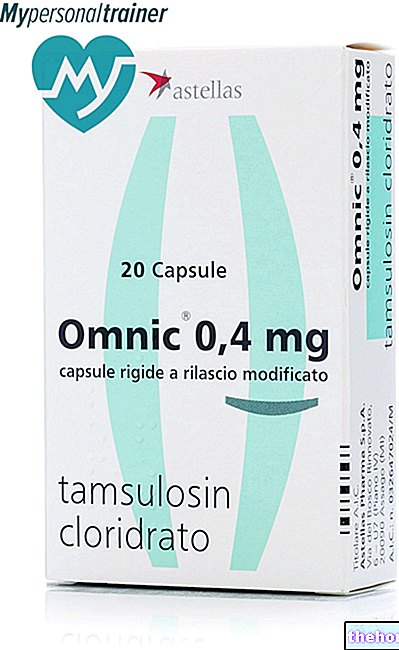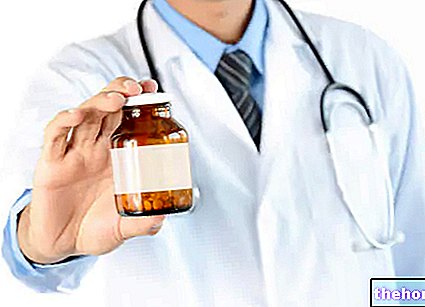Active ingredients: Hydrocortisone (Hydrocortisone 17-butyrate)
Locoidon 0.1% hydrophilic cream
Locoidon 0.1% cream
Locoidon 0.1% ointment
Locoidon 0.1% cutaneous emulsion
Locoidon 0.1% cutaneous solution
Indications Why is Locoidon used? What is it for?
LOCOIDON is indicated for the local treatment of acute, subacute and chronic skin diseases of inflammatory, allergic or eczematous origin. Eczema in various forms (atopic, chronic, allergic, contact, infantile, etc.); psoriasis; lichen planus; neurodermatitis; herpetiform dermatitis, intertrigo; inflammatory or allergic dermatitis of various types, from contact, seborrheic, burns (solar erythema, from X-rays); anogenital itching.
Contraindications When Locoidon should not be used
LOCOIDON should not be used in children under two years of age with diaper rash. Like any other cortisone preparation for topical use, the use of LOCOIDON is contraindicated in skin lesions of a tuberculous nature and in those of viral origin (including herpes, smallpox, chicken pox, etc.). It is contraindicated in patients with hypersensitivity to the active substance or to any of the excipients.
Precautions for use What you need to know before taking Locoidon
If the occlusive dressing is applied, bear in mind the possibility of any secondary infections, bacterial or fungal, which require the institution of a suitable antimicrobial therapy and the suspension of the occlusive dressing.
We do not recommend, where possible, the use of the occlusive bandage on large skin areas. In the case of prolonged treatments of large skin areas under occlusive bandage, keep in mind the possibility of systemic effects and on the adrenocortical function with possible alterations of the thermal and homeostasis. hyperthermia requiring discontinuation of treatment. Plastic films can be flammable and in themselves can cause sensitization phenomena.
Given the physico-chemical characteristics of the preparation, therapy with an occlusive dressing is not recommended. Occlusive therapy is contraindicated in patients with atopic dermatitis.
If administered in the presence of skin infections, institute adequate antibacterial or antifungal therapy and, if this fails, discontinue corticosteroid treatment.
Interactions Which drugs or foods can modify the effect of Locoidon
Tell your doctor or pharmacist if you are taking or have recently taken any other medicines, even those obtained without a prescription.
All alkaline substances (zinc oxide, mineral tar and calamine) as well as 3% salicylic acid and carb. Sol. Detergens are incompatible with Locoidon.
Warnings It is important to know that:
Any of the undesirable effects described for systemic corticosteroids, including hypoadrenalism, can also occur with topical corticosteroids, especially in pediatric patients.
Pediatric patients may prove to be more sensitive than adults to the effects of exogenous corticosteroids and in particular to dysfunction of the hypothalamic-pituitary-adrenal axis induced by topical corticosteroids, given the greater absorption due to the high ratio of skin surface to body weight. Depression of the hypothalamic-pituitary-adrenal axis, Cushing's syndrome, growth retardation and weight and intracranial hypertension have been described in children treated with topical corticosteroids. In children, manifestations of secondary hypoadrenalism include low levels of cortisolemia and failure to respond to stimulation. with ACTH. The use, especially if prolonged, of products for topical use can give rise to sensitization phenomena. In this case it is necessary to interrupt the treatment and institute a suitable therapy.
The product is not for ophthalmic use.
The cream, hydrophilic cream and skin emulsion contain parahydroxybenzoates which can cause allergic reactions (even delayed).
Use in case of pregnancy and lactation
Ask your doctor or pharmacist for advice before taking any medicine.
In pregnant women and in very early childhood, the product should be administered in cases of real need under the direct supervision of the doctor.
Dose, Method and Time of Administration How to use Locoidon: Posology
Always use Locoidon exactly as your doctor has told you. If in doubt, you should consult your doctor or pharmacist.
Locoidon 0.1% cream, thanks to its excipient with a balanced ratio between fat and aqueous phase, has an emollient and refreshing action and therefore is used in all acute, subacute and chronic skin diseases in which topical corticosteroid treatment is indicated.
Locoidon 0.1% ointment, based on fat and anhydrous, is to be preferred in chronic, clearly dry and flaking forms.
Locoidon 0.1% hydrophilic cream, in aqueous vehicle and with marked hydrophilic characteristics, finds indications in acute or subacute forms, with an extremely exudative imprint.
Locoidon 0.1% skin emulsion is a fluid emulsion whose base is made up of 15% of fatty substances and 85% of water. Due to its adherence characteristics it is indicated in areas covered by hair and, leaving no greasy residues on the skin and by virtue of its particular spreadability, it is suitable for the treatment of uncovered areas such as the face, hands and large areas. Moreover, due to its soothing effect it is particularly suitable for the treatment of acute humid forms.
Locoidon 0.1% cutaneous solution in hydroalcoholic vehicle is suitable for application on the scalp and on areas covered by hair.
In general, it is recommended to use it on limited skin surfaces. Apply a thin layer of Locoidon on the affected skin area 2-4 times a day, massaging lightly. Sometimes in the opinion of the doctor, it may be necessary to use an occlusive bandage using a sheet transparent plastic raincoat to be kept in place for 1 / 2-3 days depending on the nature, severity of the injury and the patient's condition.
Duration of treatment
According to the doctor's advice.
Overdose What to do if you have taken too much Locoidon
The excessive and prolonged use of topical corticosteroids can depress the pituitary-adrenal function causing secondary hypoadrenalism and manifestations of hypercorticism including Cushing's syndrome and in particular asthenia, arterial hypertension, heart rhythm disturbances, hypokalaemia, metabolic alkalosis.
Side Effects What are the side effects of Locoidon
Like all medicines, Locoidon can cause side effects, although not everybody gets them.
The systemic side effects of corticosteroid preparations for topical use are extremely unlikely due to the low dosages used: their appearance, however, can be favored by occlusive therapy or when large skin areas are treated with high doses or for prolonged periods of time. In these cases, these are the classic disorders of corticotherapy, in a mild and reversible form.
Sometimes there may be a sense of burning, irritation, dry skin, folliculitis, hypertrichosis, hypopigmentation.
Rare effects (more than 1 case in 10,000, less than 1 case in 1000):
skin atrophy, often non-reversible, with thinning of the epidermis, telangiectasia, purpura, epidermal striae, pustular acne, perioral dermatitis, rebound effect, skin depigmentation, dermatitis and eczema, including contact dermatitis.
Very rare effects (less than 1 case in 10,000):
Inhibition of the adrenal gland.
Effects with frequency not known:
Immune system disorders: hypersensitivity
Compliance with the instructions contained in the package leaflet reduces the risk of undesirable effects.
It is important to inform the doctor or pharmacist of any undesirable effect, even if not described in the package leaflet.
Expiry and Retention
Expiry: see the expiry date indicated on the package. The expiry date indicated refers to the product in intact packaging, correctly stored.
Warning: do not use the medicine after the expiry date indicated on the package. Keep this medicine out of the reach and sight of children.
storage
Locoidon ointment, Locoidon cutaneous emulsion, Locoidon cutaneous solution: do not store above 25 ° C.
Locoidon hydrophilic cream, Locoidon cream: do not store above 25 ° C. Do not refrigerate.
Medicines should not be disposed of via wastewater or household waste. Ask your pharmacist how to throw away medicines you no longer use. This will help protect the environment.
Composition and pharmaceutical form
Composition
Locoidon 0.1% hydrophilic cream
100 g of cream contain: Active ingredient: hydrocortisone 17-butyrate 0.1 g.
Excipients: cetylstearyl alcohol; Macrogol 25 cetostearyl ether; light paraffin oil; stringy petroleum jelly, propyl parahydroxybenzoate, butyl parahydroxybenzoate, anhydrous citric acid, anhydrous sodium citrate, purified water.
Locoidon 0.1% cream
100 g of cream contain: Active ingredient: hydrocortisone 17-butyrate 0.1 g.
Excipients: cetylstearyl alcohol; Macrogol 25 cetostearyl ether; light vaseline oil; stringy vaseline; benzyl alcohol; anhydrous citric acid; anhydrous sodium citrate; propyl parahydroxybenzoate; purified water.
Locoidon 0.1% ointment
100 g of ointment contain: Active ingredient: hydrocortisone 17-butyrate 0.1 g.
Excipients: liquid paraffin gel with 5% polyethylene.
Locoidon 0.1% cutaneous emulsion
100 g of emulsion contain: Active ingredient: hydrocortisone 17-butyrate 0.1 g.
Excipients: Macrogol 25 cetostearyl ether; cetylstearyl alcohol; white stringy petroleum jelly; white petroleum jelly; borage oil; butylhydroxytoluene; propylene glycol; sodium citrate; anhydrous citric acid; propyl-para-hydroxybenzoate; butyl-para-hydroxybenzoate; purified water.
Locoidon 0.1% cutaneous solution
100 ml of solution contain: Active ingredient: hydrocortisone 17-butyrate 0.1 g.
Excipients: glycerin; povidone; anhydrous citric acid, anhydrous sodium citrate; isopropyl alcohol; purified water.
Pharmaceutical forms and contents
Cream, hydrophilic cream, 0.1% ointment - 30 g tubes.
Skin emulsion, 0.1% skin solution - 30 ml bottles.
Source Package Leaflet: AIFA (Italian Medicines Agency). Content published in January 2016. The information present may not be up-to-date.
To have access to the most up-to-date version, it is advisable to access the AIFA (Italian Medicines Agency) website. Disclaimer and useful information.
01.0 NAME OF THE MEDICINAL PRODUCT
LOCOIDON
02.0 QUALITATIVE AND QUANTITATIVE COMPOSITION
Locoidon 0.1% cream
100 g of cream contain: hydrocortisone 17-butyrate 0.1 g
Locoidon 0.1% ointment
100 g of ointment contains: hydrocortisone 17-butyrate 0.1 g
Locoidon 0.1% hydrophilic cream
100 g of cream contain: hydrocortisone 17-butyrate 0.1 g
Locoidon 0.1% cutaneous emulsion
100 g of emulsion contain: hydrocortisone 17-butyrate 0.1 g
Locoidon 0.1% cutaneous solution
100 ml of solution contain: hydrocortisone 17-butyrate 0.1 g
For the full list of excipients, see section 6.1.
03.0 PHARMACEUTICAL FORM
Cream, hydrophilic cream, ointment, skin emulsion, skin solution.
04.0 CLINICAL INFORMATION
04.1 Therapeutic indications
Acute, subacute and chronic skin diseases of inflammatory, allergic or eczematous origin.
Eczema in various forms (atopic, chronic, allergic, contact, infantile, etc.); psoriasis; lichen planus; neurodermatitis; herpetiform dermatitis; inter-intrigues; inflammatory or allergic dermatitis of various types, from contact, seborrheic, burns (solar erythema, from X-rays); anogenital itching.
04.2 Posology and method of administration
The Locoidon 0.1% cream, thanks to its excipient with a balanced ratio between fat and aqueous phase, it has an emollient and refreshing action and therefore is used in all acute, subacute and chronic skin diseases in which topical corticosteroid treatment is indicated.
The Locoidon 0.1% ointment, based on fat and anhydrous, it is to be preferred in the chronic forms, clearly dry and flaking.
The Locoidon 0.1% hydrophilic cream, in aqueous vehicle and with marked hydrophilic characteristics, it finds indications, in acute or subacute forms, with an extremely exudative imprint.
The Locoidon 0.1% cutaneous emulsion, is a fluid emulsion whose base is made up of 15% of fatty substances and 85% of water. Due to its adherence characteristics it is indicated in areas covered by hair and, leaving no greasy residues on the skin and by virtue of its particular spreadability, it is suitable for the treatment of uncovered areas such as the face, hands and large areas. Moreover, due to its soothing effect it is particularly suitable for the treatment of acute humid forms.
For application on the scalp and on areas covered by hair, it is indicated Locoidon 0.1% cutaneous solution in hydroalcoholic vehicle.
In general, use on limited skin surfaces is recommended.
Apply a thin layer of Locoidon on the affected skin area, 2-4 times a day, massaging lightly. Sometimes in the opinion of the physician it may be necessary to use an occlusive dressing using an impermeable transparent plastic sheet to be kept in place for 3 days depending on the nature, severity of the lesion and the patient's condition. flammable and in themselves can cause sensitization phenomena. If the occlusive dressing is applied, keep in mind the possibility of any secondary infections, bacterial or fungal, which require the institution of a suitable antimicrobial therapy and the suspension of the occlusive dressing.
We do not recommend, where possible, the use of the occlusive bandage on large skin areas.
If administered in the presence of skin infections, institute adequate antibacterial or antifungal therapy and, if this fails, discontinue corticosteroid treatment.
04.3 Contraindications
Hypersensitivity to the active substance or to any of the excipients.
Locoidon should not be used in children under two years of age with diaper rash. Like any other cortisone preparation for topical use, the use of Locoidon is contraindicated in tuberculous skin lesions and in those of viral origin (herpes, smallpox, chicken pox).
04.4 Special warnings and appropriate precautions for use
Any of the undesirable effects described for systemic corticosteroids, including hypoadrenalism, can also occur with topical corticosteroids, especially in pediatric patients.
Pediatric patients may prove to be more sensitive than adults to the effects of exogenous corticosteroids and in particular to dysfunction of the hypothalamic-pituitary-adrenal axis induced by topical corticosteroids, given the greater absorption due to the high ratio of skin surface to body weight.
Depression of the hypothalamic-pituitary-adrenal axis, Cushing's syndrome, growth and weight retardation, and intracranial hypertension have been described in children treated with topical corticosteroids.
In children, manifestations of secondary hypoadrenalism include low cortisol levels and unresponsiveness to ACTH stimulation. The use, especially if prolonged, of products for topical use can give rise to sensitization phenomena. In this case it is necessary to interrupt the treatment and institute a suitable therapy.
The product is not for ophthalmic use.
In infants and children the diaper can act as an occlusive bandage, increasing the absorption of the product.
In very early childhood, the product should be administered in cases of real need and under direct medical supervision.
04.5 Interactions with other medicinal products and other forms of interaction
No negative interactions or incompatibility of use with other drugs commonly used in the relevant therapy have ever been identified.
04.6 Pregnancy and lactation
In pregnant women, the product should be administered in cases of real need under the direct supervision of the doctor.
04.7 Effects on ability to drive and use machines
The product does not affect the ability to drive and use machines.
04.8 Undesirable effects
Systemic side effects of topical corticosteroid preparations are extremely unlikely due to the low dosages employed; their appearance, however, can be favored by occlusive therapy or when large skin areas are treated with high doses or for prolonged periods of time. In these cases, these are the classic disorders of corticotherapy, in a mild and reversible form.
Side effects are listed below by system organ class and MedDRA frequency convention: Very common (≥1 / 10), Common (≥1 / 100,, Very rare (
Sometimes there may be a sense of burning, irritation, dry skin, folliculitis, hypertrichosis, hypopigmentation.
Disorders of the immune system
Not known: hypersensitivity
Endocrine pathologies
Very rare: inhibition of the adrenal gland
Skin and subcutaneous tissue disorders
Rare: Skin atrophy, often not reversible, with thinning of the epidermis, telangiectasia, purpura, epidermal striae, pustular acne, perioral dermatitis, rebound effect, skin depigmentation, dermatitis and eczema, including contact dermatitis.
04.9 Overdose
In the case of treatment of large skin areas and / or prolonged use, especially under occlusive dressing, keep in mind the possibility of systemic effects from corticosteroid reabsorption. The excessive and prolonged use of topical corticosteroids can depress the pituitary-adrenal function causing secondary hypoadrenalism and manifestations of hypercorticism including Cushing's syndrome and in particular asthenia, arterial hypertension, heart rhythm disturbances, hypokalaemia, metabolic alkalosis.
05.0 PHARMACOLOGICAL PROPERTIES
05.1 Pharmacodynamic properties
Pharmacotherapeutic group: corticosteroids, moderately active (group II), ATC code: D07AB02
The active principle of Locoidon is a non-halogenated, original synthesis corticosteroid, hydrocortisone 17-butyrate, with a marked anti-inflammatory, anti-allergic and anti-itch activity. It is therefore indicated in all acute, subacute and chronic skin diseases sensitive to treatment.
The esterification in C17 with butyric acid gives the molecule of hydrocortisone 17-butyrate a high degree of lipophilicity and therefore of affinity towards skin tissues with optimal penetration characteristics. With the anti-inflammatory activity evaluation tests, hydrocortisone 17-butyrate proved to be more potent than hydrocortisone acetate and as potent as the fluorinated corticosteroids used for comparison. Hydrocortisone 17-butyrate is made up of two physiological substances both easily metabolized from the body, with a consequent lower risk of topical or systemic side effects associated with the use of the most powerful halogenated corticosteroids.
05.2 Pharmacokinetic properties
The active substance, applied to the skin, remains for a long time in the stratum corneum, from where it slowly spreads into the deeper layers of the epidermis to reach the dermis (reserve effect). The cutaneous half-life is 20-25 hours on intact skin and about 10-15 hours when the skin surface is injured.
Hydrocortisone 17-butyrate is partially converted to 21-butyrate and rapidly hydrolyzed by plasma and hepatic esterases. The steroid is eliminated in the faeces and urine, mainly in the form of simple and conjugated metabolites.
05.3 Preclinical safety data
The acute toxicity of hydrocortisone 17-butyrate is irrelevant (LD50 orally in rabbit mice for 30 consecutive days of Locoidon in the various presentations was well tolerated both systemically and topically.
Skin tolerability is excellent and systemic activity after topical application is poor. Therefore hydrocortisone 17-butyrate has a high margin of safety.
06.0 PHARMACEUTICAL INFORMATION
06.1 Excipients
Locoidon cream: cetylstearyl alcohol; Macrogol 25 cetostearyl ether; light vaseline oil; stringy vaseline; benzyl alcohol; anhydrous citric acid; anhydrous sodium citrate; propyl parahydroxybenzoate; purified water.
Locoidon ointment: liquid paraffin gel with 5% polyethylene.
Locoidon hydrophilic cream: cetylstearyl alcohol; Macrogol 25 cetosteryl ether; light paraffin oil; stringy vaseline; propyl parahydroxybenzoate; butyl parahydroxybenzoate anhydrous citric acid; anhydrous sodium citrate; purified water.
Locoidon skin emulsion: Macrogol 25 cetostearyl ether; cetylstearyl alcohol; white stringy petroleum jelly; white petroleum jelly; borage oil; butylhydroxytoluene; propylene glycol; sodium citrate; anhydrous citric acid; propyl-para-hydroxybenzoate; butyl-para-hydroxybenzoate; purified water.
Locoidon cutaneous solution: glycerin; povidone; anhydrous citric acid; anhydrous sodium citrate; isopropyl alcohol; purified water.
06.2 Incompatibility
All alkaline substances (zinc oxide, mineral tar and calamine) as well as 3% salicylic acid and carbon sol. Detergens are incompatible with Locoidon.
06.3 Period of validity
Locoidon cream: 3 years
Locoidon ointment: 3 years
Locoidon hydrophilic cream: 3 years
Locoidon skin emulsion: 2 years
Locoidon cutaneous solution: 2 years
06.4 Special precautions for storage
Locoidon cream, Locoidon hydrophilic cream
Do not store above + 25 ° C. Do not refrigerate.
Locoidon ointment, Locoidon cutaneous emulsion, Locoidon cutaneous solution
Do not store above + 25 ° C.
06.5 Nature of the immediate packaging and contents of the package
Locoidon cream, Locoidon hydrophilic cream and Locoidon ointment they are contained in aluminum tubes, internally coated with 30 g araldite.
Locoidon cutaneous emulsion and Locoidon cutaneous solution they are contained in 30 ml polythene bottles.
06.6 Instructions for use and handling
No special instructions.
Unused medicine and waste derived from this medicine must be disposed of in accordance with local regulations.
07.0 MARKETING AUTHORIZATION HOLDER
Astellas Pharma S.p.A. - Via delle Industrie 1 - 20061 Carugate (Milan)
08.0 MARKETING AUTHORIZATION NUMBER
Locoidon 0.1% ointment: 023325018
Locoidon 0.1% hydrophilic cream: 023325020
Locoidon 0.1% cutaneous solution: 023325044
Locoidon 0.1% cream: 023325057
Locoidon 0.1% skin emulsion: 023325083
09.0 DATE OF FIRST AUTHORIZATION OR RENEWAL OF THE AUTHORIZATION
Locoidon 0.1% ointment - Registration 12 August 1976 - Renewal of authorization June 2005
Locoidon 0.1% hydrophilic cream - Registration 12 August 1976 - Renewal of authorization June 2005
Locoidon 0.1% cutaneous solution - Registration 12 August 1976 - Renewal of authorization June 2005
Locoidon 0.1% cream - Registration 10 June 1983 - Renewal of authorization June 2005
Locoidon 0.1% skin emulsion - Registration 10 June 1996 - Renewal of authorization June 2005
10.0 DATE OF REVISION OF THE TEXT
March 2009




























